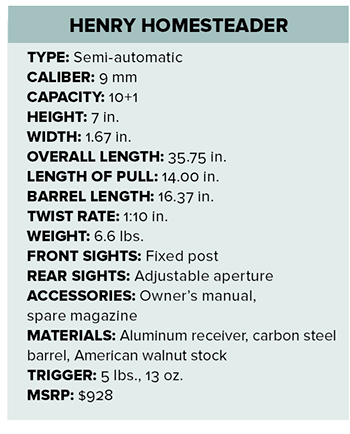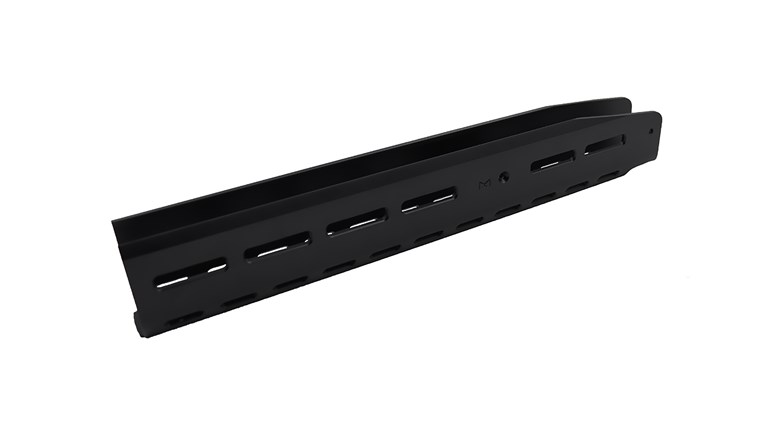
When everything you need to survive must fit between a pair of saddlebags and your belt, simplicity is key. Settlers of the Old West knew this, and, as such, carbines that fired the same rounds as their pistols were highly desirable as one way to lighten the load. Additionally, procuring ammunition sometimes proved to be difficult, so a common chambering was ideal.
The same benefits apply today, whether you’re looking to defend a ranch or a suburban home, so Henry Repeating Arms has decided to introduce the company’s first centerfire, semi-automatic design. Dubbed the “Homesteader,” it pays homage to those who have made the journey to expand this great country.
Henry’s first pistol-caliber carbine (PCC) is chambered in 9 mm Luger, the round of choice for today’s cowboy (and everybody else). Departing from its signature tube-fed designs, the new carbine feeds from proprietary detachable box magazines, with both a 5 and 10-rounder included. Henry also offers conversion kits that allow the Homesteader to accept Glock or SIG/M&P mags.
Although the magazine system isn’t particularly “Henry,” the Homesteader’s consideration of left-handed shooters certainly is. Southpaws (like myself) appreciate lever guns because nothing is favored for right-handed operation. Henry’s new semi-automatic follows this principle, beginning with the magazine release. Located on the underside, just forward of the well itself, is a countersunk lever that can be rolled back with the pinkie of the support hand, regardless of which one that is for you. Working back, there is a dual-sided bolt catch that is useful for storing the Homesteader with the action open or cleaning the bore without a complete disassembly.

Returning the bolt to battery requires a slight tug to free it from this mechanism, which cannot be performed if an empty magazine is inserted. This brings us to a reversible charging handle—one of my favorite and less-common features. The Homesteader’s receiver has a slot milled on the left side, which allows for the handle to be plucked free and swapped over. No tools are required to do this, meaning you can swap it right on the range to accommodate both dexterities. Lastly, a tang-mounted, push-to-fire safety can be hit with either thumb, making this carbine fully ambidextrous without making it more complex than it needs to be.
More people will peg the Homesteader as a Henry creation when they see the furniture. Crafted from American Walnut, it faithfully embodies the company slogan of “made in America, or not at all.” The fore-end features three sides of gentle texturing and a sling stud located on the underside. The buttstock is built to create a 14-inch length of pull and is capped with a half-inch-thick rubber recoil pad. The same texture from the fore-end can be found on both sides of the pistol grip, as well as a sling stud located in the rear. With a sea of plastic and aluminum-stocked PCCs out there, I found this look refreshing.
 Henry wanted you to be able to enjoy your new firearm right out of the box, so a set of fully adjustable aperture-style sights comes standard. These are mounted directly to its 16.37-inch threaded barrel, ensuring they remain aligned. Additionally, for those wishing to add a bit of magnification or illumination, the receiver comes drilled and tapped for Weaver 62B hardware. I prefer both, so I affixed a one-piece Picatinny rail and topped my sample off with an EOTech VuDu 1-8x low-power variable optic. Its lightweight nature is completely at home with firearms like this and affords me a repeatable sight picture to capitalize on the gun’s accuracy potential.
Henry wanted you to be able to enjoy your new firearm right out of the box, so a set of fully adjustable aperture-style sights comes standard. These are mounted directly to its 16.37-inch threaded barrel, ensuring they remain aligned. Additionally, for those wishing to add a bit of magnification or illumination, the receiver comes drilled and tapped for Weaver 62B hardware. I prefer both, so I affixed a one-piece Picatinny rail and topped my sample off with an EOTech VuDu 1-8x low-power variable optic. Its lightweight nature is completely at home with firearms like this and affords me a repeatable sight picture to capitalize on the gun’s accuracy potential.
Good groups require good ammunition, but which ones? With the 9 mm selection now restored to pre-pandemic levels, I chose three on the lighter side, as they typically bode well with unsuppressed use: Hornady’s Critical Defense Lite 100-grain FTX, Federal’s 135-grain Hydra-Shok and the 124-grain Speer Gold Dot.
I started my evaluation by zeroing the gun with the mid-weight ammunition to get a feel for the recoil and the trigger. For a direct-blowback design, I can’t say it was awful. Although not as straight as, say, an AR-15, the stock geometry helped mitigate muzzle rise. The trigger had a fair amount of take-up but then finished with a crisp, clean break at just north of six-and-a-half pounds. My only gripe in this department was the over-travel, as I felt it robbed the gun of a bit of accuracy; however, with groups as tight as 0.6 inches, it’s fair to say that this is negligible.
With zeroing and accuracy determination complete, I moved to the action range to run the gun a little harder and make use of the 1x setting on my scope. Starting with transition drills, I bounced back and forth between two steel targets, serving each with a controlled pair. This routine was lightning fast, with splits down to as quick as 0.28 seconds with the lightest ammunition. Running a Texas Star routine was equally expedient, as the recoil put me right on top of the next plate the moment it was time to press the trigger. Reloads were hasty, largely due to the forceful magazine ejection, and I could not get this carbine to jam.
I finished my day by exhausting more than 200 rounds of ammunition, which happens fast when you have an easy-to-shoot firearm like the Homesteader. Henry clearly put plenty of thought into the design, as the gateway to reputation loss is often a deviation from the norm. The new PCC is built with the same attention to detail, style and functionality as any of its models and has everything to help you tame a new frontier, whether it be hundreds of miles away or just right outside your back door.


































